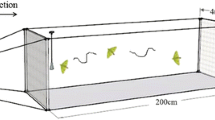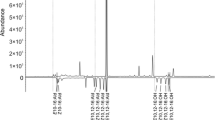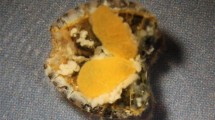Abstract
Orius minutus (L.) (Heteroptera: Anthocoridae) is a natural enemy of agricultural pests such as thrips, aphids, and various newly hatched insect juveniles. In this study, we conducted 1) behavioral assays for evidence of contact sex pheromone activity in trails of O. minutus, and 2) chemical analysis to identify the essential chemical components of the trails. Males showed arrestment to trails of mature virgin females but not to trails from either conspecific nymphs or immature females. Females also showed arrestment to trails from conspecific males, although the response was weaker than that exhibited by males. The activity of female trails lasted for at least 46 h after deposition. Males showed a response irrespective of mating experience. Following confirmation that a contact sex pheromone was present in the trails of female O. minutus, we used a bioassay-driven approach to isolate the active chemicals. After fractionation on silica gel, the n-hexane fraction was found to be biologically active to males. A major compound in the active fraction was (Z)-9-nonacosene; this compound was found only in trail extracts of mature virgin females. Synthetic (Z)-9-nonacosene arrested O. minutus males, indicating that it is the major active component of the contact sex pheromone in the trails of female O. minutus.








Similar content being viewed by others
References
Aldrich JR (1999) Status of semiochemical research on predatory heteroptera. In: M C, Jr R (eds) Predatory heteroptera: Their ecology and use in biological control. Lanham, Entomological Society of America, Maryland, pp. 33–48
Aldrich J, Oliver J, Shifflet T, Smith C, Dively G (2007) Semiochemical investigations of the insidious flower bug, Orius insidiosus (say). J Chem Ecol 33:1477–1493
Ardeh M, De Jong PW, Loomans AJM, Van Lenteren JC (2004) Inter- and intraspecific effects of volatile and nonvolatile sex pheromones on males, mating behavior, and hybridization in Eretmocerus mundus and E. eremicus (hymenoptera: Aphelinidae). J Insect Behav 17:745–759
Arijs Y, De Clercq P (2001) Rearing Orius laevigatus on cysts of the brine shrimp Artemia franciscana. Biol Control 21:79–83
Bernal J, Luck R (2007) Mate finding via a trail sex pheromone by Aphytis melinus DeBach (hymenoptera: Aphelinidae) males. J Insect Behav 20:515–525
Bordereau C, Pasteels J (2011) Pheromones and chemical ecology of dispersal and foraging in termites. In: Bignell DE, Roisin Y, Lo N (eds) Biology of termites: a modern synthesis. Springer, Netherlands, pp. 279–320
Böröczky K, Crook D, Jones T, Kenny J, Zylstra K, Mastro V, Tumlinson J (2009) Monoalkenes as contact sex pheromone components of the woodwasp Sirex noctilio. J Chem Ecol 35:1202–1211
Collatz J, Tolasch T, Steidle JLM (2009) Mate finding in the parasitic wasp Cephalonomia tarsalis (Ashmead): more than one way to a female's heart. J Chem Ecol 35:761–768
Drijfhout FP, Groot AT, Van Beek TA, Visser JH (2003) Mate location in the green capsid bug, Lygocoris pabulinus. Entomol Exp Appl 106:73–77
Fauvergue X, Hopper KR, Antolin MF (1995) Mate finding via a trail sex pheromone by a parasitoid wasp. Proc Natl Acad Sci U S A 92:900–904
Ginzel M, Moreira J, Ray A, Millar J, Hanks L (2006) (Z)-9-nonacosene - major component of the contact sex pheromone of the beetle Megacyllene caryae. J Chem Ecol 32:435–451
Greenstone MH, Szendrei Z, Payton ME, Rowley DL, Coudron TC, Weber DC (2010) Choosing natural enemies for conservation biological control: use of the prey detectability half-life to rank key predators of Colorado potato beetle. Entomol Exp Appl 136:97–107
Hénaut Y, Alauzet C, Lambin M (2002) Effects of starvation on the search path characteristics of Orius majusculus (Reuter) (het., anthocoridae). J Appl Entomol 126:501–503
Hinomoto N, Nagamori S, Kakimoto K, Shimizu T, Higaki T, Muraji M, Noda T, Kawasaki K (2009) Molecular identification and evaluation of Orius species (heteroptera: anthocoridae) as biological control agents. Jpn Agr Res Q 43:281–288
Hoover K, Keena M, Nehme M, Wang S, Meng P, Zhang A (2014) Sex-specific trail pheromone mediates complex mate finding behavior in Anoplophora glabripennis. J Chem Ecol 40:169–180
Horton DR (2008) Minute pirate bugs (Hemiptera: Anthocoridae). In: JL C (ed) Encyclopedia of entomology, vol 3. Springer, Dordrecht, The Neth, pp. 2402–2412
Kainoh Y, Nemoto T, Shimizu K, Tatsuki S, Kusano T, Kuwahara Y (1991) Mating-behavior of Ascogaster reticulatus Watanabe (hymenoptera: Braconidae), an egg-larval parasitoid of the smaller tea tortrix, Adoxophyes sp. (Lepidoptera: Tortricidae). III identification of a sex pheromone. Appl Entomol Zool 26:543–549
Kakimoto K, Inoue E, Yoshida T (2002) Seasonal changes in population density and species composition of Orius spp. in mulberry fields. Jpn J Appl Entomol Zool 46: 209–215 in Japanese with English abstract
Kakimoto K, Urano S, Noda T, Matuo K, Sakamaki Y, Tsuda K, Kusigemati K (2005) Comparison of the reproductive potential of three Orius species, O. strigicollis, O. sauteri, and O. minutus (heteroptera: anthocoridae), using eggs of the Mediterranean flour moth as a food source. Appl Entomol Zool 40:247–255
Kamano Y, Shimizu K, Kainoh Y, Tatsuki S (1989) Mating behavior of Ascogaster reticulatus Watanabe (hymenoptera: Braconidae), an egg-larval parasitoid of the smaller tea tortrix, Adoxophyes sp. (Lepidoptera: Tortricidae): II. Behavioral sequence and a role of sex pheromone. Appl Entomol Zool 24:372–378
Kapranas A, Giudice DL, Peri E, Millar JG, Colazza S (2013) Emergence, dispersal, and mate finding via a substrate-borne sex pheromone in the parasitoid Metaphycus luteolus. Entomol Exp Appl 148:74–83
Kawai A (1995) Control of Thrips palmi Karny (Thysanoptera: Thripidae) by Orius spp. (heteroptera: anthocoridae) on greenhouse eggplant. Appl Entomol Zool 30:1–7
King EG, Coleman RJ (1989) Potential for biological control of Heliothis species. Annu Rev Entomol 34:53–75
Kohno K, Kashio T (1998) Development and prey consumption of Orius sauteri (Poppius) and O. minutus (L.) (Eteroptera: Anthocoridae) fed on Franklinilla occidentalis (Pergande) (Thysanoptera: Thripidae). Appl Entomol Zool 33: 227–230
Lattin JD (1999) Bionomics of the anthocoridae. Annu Rev Entomol 44:207–231
Leon-Beck M, Coll M (2009) The mating system of the flower bug Orius laevigatus. Biol Control 50:199–203
Mendes SM, Bueno VHP, Carvalho LM (2003) Influence of the presence/absence of males in the oviposition of Orius insidiosus (say) (Hemiptera: anthocoridae). IOBC WPRS Bull 26:143–146
Morgan DE (2009) Trail pheromones of ants. Physiol Entomol 34:1–17
Morita A, Matsuyama S, Oguma Y, Kuwahara S (2005) Simple synthesis of the major sex pheromone components of Drosophila ananassae and D. pallidosa. Biosci Biotechnol Biochem 69:1620–1623
Nagai K (1991) Predatory characteristics of Orius sp. on Thrips palmi Karny, Tetranychus kanzawai Kishida, and Aphis gossypii Glover. Jpn J Appl Entomol Zool 35: 269–274 in Japanese with English abstract
Nakashima Y, Hirose Y (1999) Trail sex pheromone as a cue for searching mates in an insect predator Orius sauteri. Ecol Entomol 24:115–117
Nakashima Y, Teshiba M, Hirose Y (2002) Flexible use of patch marks in an insect predator: effect of sex, hunger state, and patch quality. Ecol Entomol 27:581–587
Pompanon F, De Schepper B, Mourer Y, Fouillet P, Bouletreau M (1997) Evidence for a substrate-borne sex pheromone in the parasitoid wasp Trichogramma brassicae. J Chem Ecol 23:1349–1360
Reinhardt K, Anthes N, Lange R (2014) Copulatory wounding and traumatic insemination. In: Rice WR, Gavrilets S (eds) The genetics and biology of sexual conflict. Cold Spring Harbor Laboratory Press, Cold Spring Harbor, NY, pp. 115–139
Runcie C (1987) Behavioral evidence for multicomponent trail pheromone in the termite, Reticulitermes flavipes (Kollar) (Isoptera: Rhinotermitidae). J Chem Ecol 13:1967–1978
Shapiro JP, Shirk PD, Kelley K, Lewis TM, Horton DR (2010) Identity of two sympatric species of orius (Hemiptera: heteroptera: anthocoridae). J Insect Sci 10:189
Silk PJ, Sweeney J, Wu J, Sopow S, Mayo PD, Magee D (2011) Contact sex pheromones identified for two species of longhorned beetles (Coleoptera: Cerambycidae) Tetropium fuscum and T. cinnamopterum in the subfamily Spondylidinae. Environ Entomol 40:714–726
Swern D. (1953) Epoxidation and hydroxylation of ethylenic compounds with organic peracids. Org React 7:378–380
Van Lenteren JC, Roskam MM, Timmer R (1997) Commercial mass production and pricing of organisms for biological control of pests in Europe. Biol Control 10:143–149
Witzgall P, Kirsch P, Cork A (2010) Sex pheromones and their impact on pest management. J Chem Ecol 36:80–100
Xiao W, Honda H, Matsuyama S (2011) Monoenyl hydrocarbons in female body wax of the yellow peach moth as synergists of aldehyde pheromone components. Appl Entomol Zool 46:239–246
Yano E, Jiang N, Hemerik L, Mochizuki M, Mitsunaga T, Shimoda T (2005) Time allocation of Orius sauteri in attacking Thrips palmi on an eggplant leaf. Entomol Exp Appl 117:177–187
Yasunaga T (1997a) The flower bug genus Orius wolff (Heteroptera: Anthocoridae) from Japan and Taiwan, part I. Appl Entomol Zool 32:355–364
Yasunaga T (1997b) The flower bug genus Orius wolff (Heteroptera: Anthocoridae) from Japan and Taiwan, part II. Appl Entomol Zool 32:379–386
Yasunaga T (1997c) The flower bug genus Orius wolff (Heteroptera: Anthocoridae) from Japan and Taiwan, part III. Appl Entomol Zool 32:387–394
Zhang A, Oliver JE, Chauhan K, Zhao B, Xia L, Xu Z (2003) Evidence for contact sex recognition pheromone of the asian longhorned beetle, Anoplophora glabripennis (Coleoptera: Cerambycidae). Naturwissenschaften 90:410–413
Acknowledgments
We thank Ikuko Hashimoto for her assistance with rearing the insects at NIAS and with performing the laboratory experiments. This work was supported by the Council for Science, Technology and Innovation (CSTI), the Cross-ministerial Strategic Innovation Promotion Program (SIP), and the “Technologies for creating next-generation agriculture, forestry and fisheries” program (funding agency: Bio-oriented Technology Research Advancement Institution, NARO).
Author information
Authors and Affiliations
Corresponding author
Rights and permissions
About this article
Cite this article
Maeda, T., Fujiwara-Tsujii, N., Yasui, H. et al. Female Sex Pheromone in Trails of the Minute Pirate Bug, Orius minutus (L). J Chem Ecol 42, 433–443 (2016). https://doi.org/10.1007/s10886-016-0702-2
Received:
Revised:
Accepted:
Published:
Issue Date:
DOI: https://doi.org/10.1007/s10886-016-0702-2




